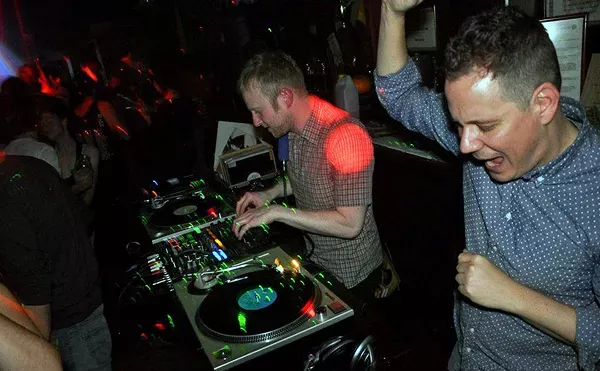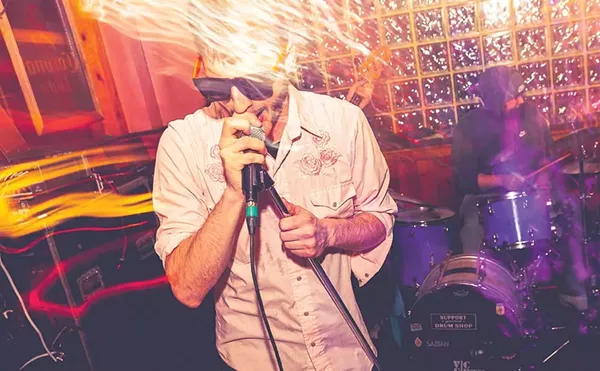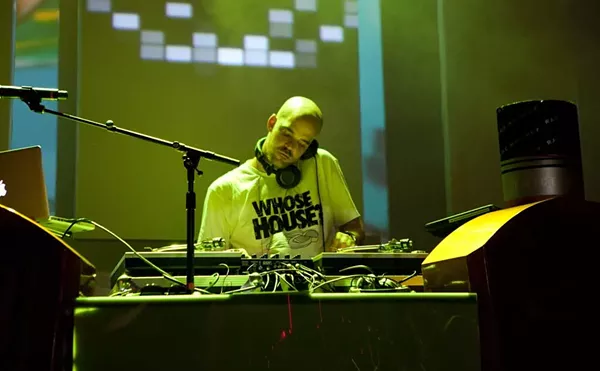“Go up Woodward toward Baltimore. No, that’s the one with the White Castle. Yeah, past the railroad tracks. Take a right and look for the door that looks like a wrought-iron sculpture. There’s like a trumpet on it and if you look close, you can make out the words ‘Art Space.’ You can park in the mud lot across the street, but look out for the broken 40s. Yeah, I don’t know. It’s a crapshoot, but it’s five bucks and Ben says the band is really, really good.”
Thus were many introduced to the Detroit Art Space, the massive former storage space and makeshift auto garage that for the last three years provided a safe haven for unsafe music. No, no, not the alarmist Fox 2 News at 10 version of unsafe. Rather, the Art Space that has kept its doors open to and actively sought out what is most easily described as Detroit’s genuine underground — artists plying sonic crafts wild and free from the commercial appeal constraints and fashionable trappings of Detroit’s by-now-accepted rock ’n’ roll orthodoxy.
A glance at the Art Space schedule might reveal, over the course of a single month, the challenging jazz of Faruq Z. Bey, Viki’s homemade electronic soundscapes, Mammal’s hardcore noise, Human Eye’s weirdo spazz-punk, the Blackman’s hip-hop mixmastery as well as the occasional singer-songwriter looking for a latte-free crowd. And then there was the trapeze circus, the butoh-informed modern dance and a dozen other shows that never would have gotten a return phone call if it weren’t for a place like the DAS.
In other words, all bets were off, as long as the sounds were interesting. Frequent DAS performer Lindsay Kartz (aka Viki and one half of the duo Midweek Vacation) sums up the appeal of DAS succinctly: “The space provided a place for artists and musicians to express themselves whether it be tacky or loud. NO RULES,” she shout-writes via e-mail, “except hurting people — if it was involuntary pain.”
In and of itself, the Art Space is and was an anomaly on a scene — that loose collection of artists that on any given night provides a snapshot of a city’s creative health — that seems increasingly encroached upon by commercial concerns and mired in an apparent aesthetic hangover from the halcyon days of 2002’s “garage rock” explosion.
What’s more, because it’s anti-commercial by design and DIY to the bone, the Art Space has proved a key link in the chain of nontraditional venues — squat houses, artists’ collectives, nominal coffeehouses and other make-do places with four walls and a roof — that have been the hothouses for Detroit’s underground over the past 20-some years. Places like the Cass Corridor’s Freezer Theatre that launched Negative Approach and Detroit’s early ’80s hardcore scene and in the process birthed the spirit of Chicago indie label powerhouse Touch & Go Records. Places like 404 Willis and the adjacent Red Door that served up complicated jams to a music-educated scene, then offered them a place to let their hair down. Joints such as Zoot’s Coffee in Detroit, the Lab in Ann Arbor and the Green Room in Ypsilanti that opened their basement, stage and front rooms respectively to noise freakouts, indie-rock bliss and funky freeform dance parties in the early and mid-’90s and managed to birth or next-generation midwife such current musical darlings as Saturday Looks Good to Me, Andrew WK, Tamion 12-inch and the Von Bondies, as well as infuse the scene’s spirit with a record-collecting zeal that found outlet in Zoots’ Ex.A.T (Experimental Ambient Techno) nights. (And the more recent and wildly popular funk dance parties helmed by former Lab folks at detroit contemporary gallery.)
More recently, the Gold Dollar shared this spirit, though it was a licensed bar. And, to some extent, the hibernation of detroit contemporary — a hybrid space that opened its doors to music to pay the bills and offered premium art goods during the day — contributed to Detroit Art Space’s necessary ascendancy. All of these places connected Detroit to the larger independent music community around the United States, Canada and the rest of the world by assuring that if a band or a musician chose to take a day off between Chicago and Cleveland on their way to New York, they’d have a place to rock and a place to crash in the Motor City.
But, more importantly, they offered ad hoc clubhouse spaces to like-and-not-likeminded individuals to connect and swap war stories, tips, ideas, records, videotapes and cultural conspiracy theories. This is the stuff of which communities are made — hardcore, indie rock, avant-garde. And as idealistic as it may sound, Detroit Art Space’s connection to this tradition was by design.
Filmmaker Ben Hernandez has been curator, booker, promoter, doorman, soundman and janitor of the place since shortly after its opening in 2001.
“We wanted to be a place that broke down that weird unspoken antagonism that happens in ‘real’ clubs,” he says. “Between the venue and the band, between the venue and its patrons and, weirdly, sometimes between the band and their audience!”
This is something, Hernandez notes, that he took notice of when he started attending shows at Zoot’s and later at the Gold Dollar. And in the case of the Gold Dollar, it was proprietor Neil Yee’s stated goal to create a place where, he says, “I’d want to go. A place that I’d want to play.”
Brad Hales, one of the organizers behind the Lab and the soon-to-be-reinvigorated monthly funk dance parties at the detroit contemporary, sums it up: “Dealing with bars is usually the pits, and one reason that places like the Lab, 404 Willis, Zoot’s, Trumbull Theatre, detroit contemporary, Detroit Art Space, etc., exist is that there needs to be another outlet.”
“It’s a labor of love, and your space usually gets trashed, targeted by police, and eventually closed down,” Hales continues. “You get to babysit a bunch of people who are usually drinking. So it’s a big commitment, because it’s not easy. You have to truly believe that bringing music to people is really worth the huge hassle.”
Hernandez, for his part, is nothing if not a true believer. “DAS was a breeding ground for people to get together and share ideas — consciously or unconsciously,” he says.
“Not in a hippie-commune, exclusionist kind of way or in a bohemian, lofty, elitist kind of way, either. It was a place where anyone could step up and share their ideas no matter how crazy they seemed. Often, the crazier the ideas, the better and more fun that made the given event.”
The Detroit Art Space was born in early 2001 when longtime Cass Corridor arts community members Don and Judy Thibodeaux took over the space, converting the front lobby area into a gallery, not really sure what to make of the cavernous rear space. Their idea was simple — open a community joint where they could showcase their cohorts’ artwork. The Thibodeauxs kept it casual. Sometimes too casual, as it turned out, but casual nonetheless.
“When the Thibodeaux family began Detroit Art Space, they were not trying to openly defy all of the art gallery conventions,” Hernandez says. “They just weren’t those kind of people, so the place wasn’t that kind of place. It was a natural, beautiful thing.”
At some point not too long after signing the lease, they also hatched the idea to host shows by folks like Faruq Z. Bey and Hakim Jami — both veteran jazz musicians who didn’t fit easily into the city’s mainstream scene, but who are also held in high regard by Detroit’s untamed corps of musical explorers.
The earliest consistent gigs at DAS were the Sunday jazz brunches, which were co-curated by the DAS and Immigrant Suns/Scavenger Quartet member Joel Peterson. Various incarnations of Peterson’s outfits would also perform at the brunches as would the Art Space’s early out-jazz repertory company. The results were musically dynamic if not financially lucrative.
Gold Dollar’s Yee, who attended a few of the brunches, attests to the spirit: “I really liked their brunch idea, though I didn’t see many others there appreciating it. At least while I was in town, it didn’t seem to be working financially, but who cares? It’s about the idea, the act and giving it a go.”
Hernandez was asked to take the booking and promotion reins shortly after he signed on as an enthused volunteer. Soon, his experiences from knocking around the scene as an indie filmmaker, show promoter, food service worker and fan all gelled and he was giving the Thibodeauxs advice on making their shows better.
“Don wouldn’t set up a table at the entrance,” Hernandez says. “He’d go around to people after the show started and ask them for money and more likely than not they wouldn’t give it to him.”
The Art Space didn’t exactly get off to an auspicious start even under Hernandez’s watch. “One of my first shows,” he says, “the P.A. caught on fire and just started smoking during the show. And then a couple nights later, someone crashed through the back door of the space with their car and stole the P.A.!” he adds, laughing. “They made off with a burned-out P.A. So we reinforced the door and were forced to get a new P.A. But that’s how we actually got a decent P.A.”
The Art Space paid its bills in the early days — and occasionally thereafter — as a rental hall for fourth-generation techno teens from the burbs. The necessity still rankles Hernandez. More than some of the other patrons over the years, the techno kids tended to trash the place. “I actually heard a dude say, ‘Oh, who cares? It’s just Detroit. That’s what it’s for,’” Hernandez says. “They just had no clue.”
It’s certainly one of the risks of running a blank-slate space in the middle of what is still perceived by many as a bombed-out city. But the positive end of that is that a blank slate equals, essentially, an invitation for musical meet-ups, and Hernandez and DAS have managed to cross a lot of boundaries. On any given night you’d find thrift-store kids mingling with desperately-bored would-be suburban punks, old-school been-there punks from the Corridor, curious art-goers, CCS and WSU college students and dudes from the neighborhood who just happened to drop in.
Moreover, in that gray area where genres get hyphenated and neologisms are coined by critics, ideas get passed around like a bottle at a campfire. That word-of-mouth helped get people in the door at DAS, and qualified them as at least partially open-minded.
Conversely, the city’s ink-stained rock scene never really “got” the DAS. They’d show up there occasionally, but their studied bar pose and proclivity for expecting to be on guest lists didn’t match the unscripted dialogue that was a night at the Art Space. Hernandez relates the story of two members of a prominent band showing up one night “all in their leather jackets” and perfectly unkempt hair.
“Their attitude was just so different,” Hernandez says. “Basically the kids just ignored them. But here were all these kids — they had no idea what to make of the kids with half-dyed asymmetrical haircuts and crazy handmade fashion.”
As a brand name, the Art Space had been established by the local music cognoscenti only as recently as last year. To this day, the biggest show the place ever hosted — a show by Providence, R.I., noisy punks Lightning Bolt — topped out at around 200 people.
“You know, we knew there was something — we weren’t sure if it was good or bad — when Shannon McCarthy wrote [in Real Detroit] that a band playing here was a very ‘DAS’ band,” Hernandez says, chuckling. “I wasn’t sure what that meant, but it was funny.”
And that’s right about when promoters started calling. Enough bands had been through the joint over the course of two-plus years for word-of-mouth to be established on the national touring circuit. Ironically enough, when the promoters started calling, that was the beginning of the end for the Art Space.
DAS did a handful of shows set up by national booking agents and, Hernandez notes as a point of pride, they always paid those bands. In fact, no band that played the Art Space was stiffed, no matter how tight the money was. DAS would eat the loss and make sure the band got its dough. And so the pressure built to either hang it up or become the venue they didn’t want to become.
“Toward the end, it became clear that we needed to do things like a real venue or stop doing shows,” Hernandez says.
“We had actually planned on closing a few other times, but someone would always call and want to set up a show and we’d do it. The landlord would call and say, ‘I thought you weren’t doing any more shows!’
“The Holy Shit!!! Festival [held last July 4 weekend] was the perfect encapsulation of what we wanted to do,” Hernandez says. Over the course of the three days, he says, hundreds of people got exposed to music they’d never hear any other way. And that plants the seeds for another generation to carry the spirit forward.
“As we are forced financially to become more ‘club-like’ we begin to move further and further away from the genesis of DAS as an idea of its own. We would have to join in and play the game we despise so much,” Hernandez says.
“Why the hell would any free-thinking individual in their right mind want us to become that? We are by no means pretentious enough to believe that we are the only home to free and fresh ideas. And our demise certainly doesn’t mark the end of the free flow of creative ideas in Detroit,” he says.
Kartz, for her part, isn’t so sure.
“There aren’t any venues within the city that put artistic integrity before money or ‘fashion design.’ I sincerely hope that there will be something that picks up where the DAS left off.”
And this is as close to the heart of the matter as anyone will ever get when recalling the Detroit Art Space. It married place, space and ability to create an environment that matched the spirit of its ZIP code.
“That’s what Detroit is all about — space, freedom, individuality and a love of the romance of being the underdog,” Hernandez says. “That is the underground and whenever or wherever the underground is co-opted, a new set of places and ideas emerge in response to that.”
Righteous to the end.
The final two shows at the Detroit Art Space (101 E. Baltimore, Detroit; 313-664-0445) are Wednesday, Dec. 29 (with Chromelodeon, the Evolution Control Committee and the Dusk), and Thursday, Dec. 30 (with Tamion 12-Inch, Awesome Color and Misty). Chris Handyside is a freelance writer for Metro Times. Send comments to letters@metrotimes.com






